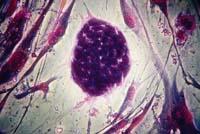They manage to make the first clonic embryo
2008/02/01 Elhuyar Zientzia Iturria: Elhuyar aldizkaria

The Californian company Stemagen has managed to make clonic embryos from the surface cells of an adult. For this purpose, the researchers have used eggs from three women. In fact, Dolly has been based on the same technique they used to create the famous sheep, nuclear transfer.
The three women gave a total of 29 eggs, to which, after removing the nucleus, the nucleus of a man's surface cell was introduced. Later, the eggs were excited to begin to develop embryos and finally it has been possible to reach five blastocyst embryos. Researchers have shown that at least one in five is the clone of man.
The researchers themselves recognize that the experiment carried out is nothing more than a small advance on the path to stem cells. The technique has been used for a long time, and for this time to have such good results, several factors have been joined. On the one hand, they have used eggs of very good quality. On the other hand, one of the components of the culture of cellular growth is hyaluronidase, a protein that, although usually cow, has used human hyaluronidase on this occasion. These and other details have contributed to success.
However, this technique of obtaining stem cells is limited by the need for female eggs and by the ethical and legal problems to achieve them. Despite the problems, California researchers have shown that the technique of creating human clones is useful and now intend to try to create stem cells for their therapeutic use.

Gai honi buruzko eduki gehiago
Elhuyarrek garatutako teknologia





